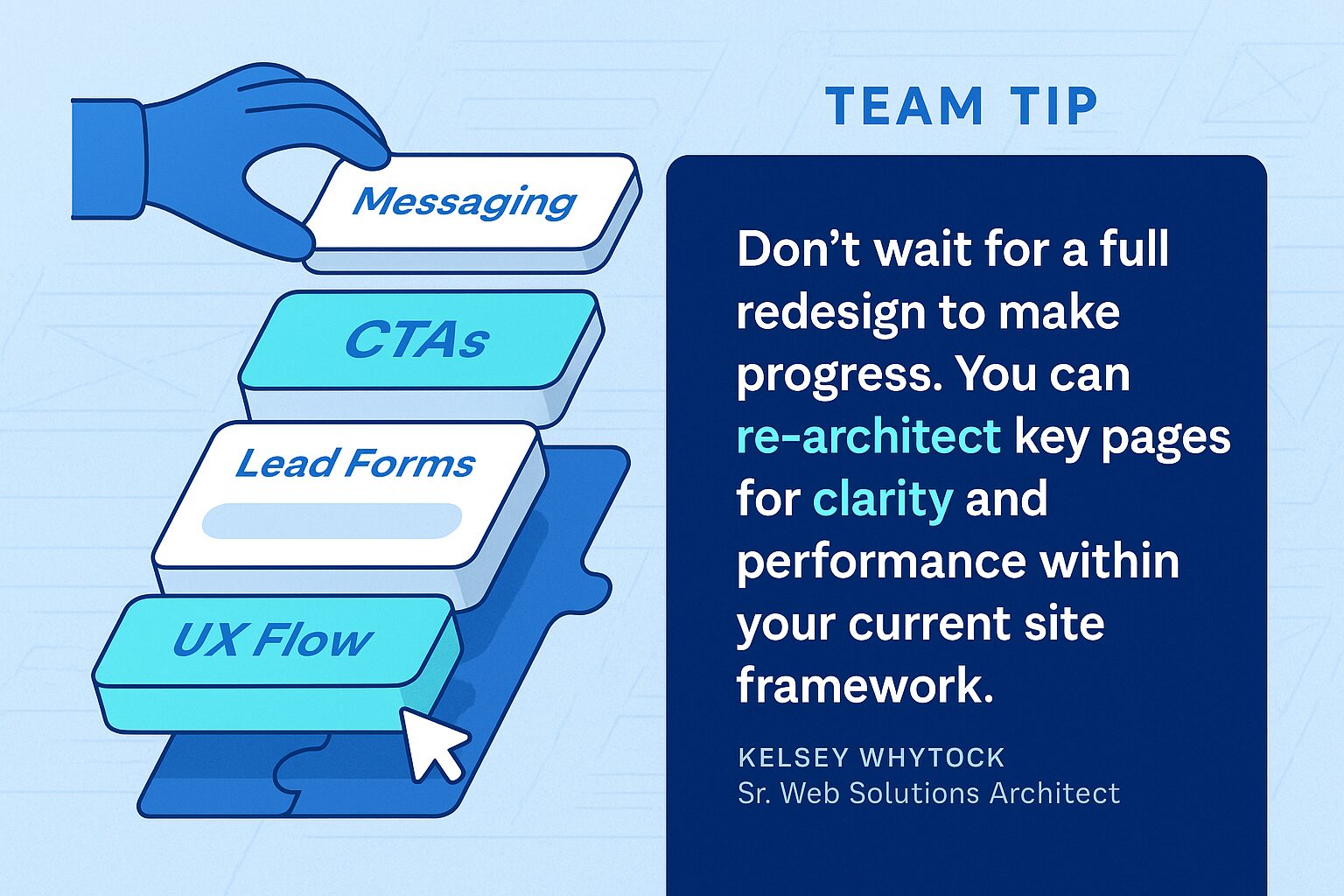TL;DR:
- A redesign alone won’t solve deeper performance or alignment issues
- Strategy misalignment often shows up as slow execution or unclear value
- Marketing leaders need a website that supports revenue, not just looks modern
- A strategic shift focuses on goals, users, and measurement, not surface-level fixes
- Ongoing website support ensures your site keeps evolving with your business
Your site looks “fine.” The design isn’t the problem. But something still feels off. Campaigns take too long to launch. The metrics don’t connect to outcomes. You’re constantly translating business priorities into workaround briefs. The site isn’t broken, but it’s not helping either.
This is where many marketing leaders find themselves stuck with a site that technically works, but doesn’t support their goals. When that happens, it’s time to rethink the strategy behind the website, not just the layout on the screen.
Signs You’ve Outgrown Your Website Strategy
Even the most beautiful site can create friction if it’s not built for growth. If your website is rooted in outdated goals or built around a one-time launch mindset, it can quietly hold back progress.
Here’s what to watch for:
- Slow campaign execution. You need custom pages or new CTAs but hit dev roadblocks every time.
- Unclear conversion paths. Users click around, but the next step is never obvious.
- Outdated buyer journeys. Your site still assumes a sales-led process, but buyers want self-service now.
- Disconnected metrics. You’re tracking sessions and bounce rate, but can’t show pipeline impact.
- Inconsistent messaging. Site copy lags behind your GTM strategy or sales enablement efforts.
If two or more of these sound familiar, it’s not just a UX issue. It’s a strategy gap.

Why Strategy Outpaces Design in Impact
Design is what people see. Strategy is how the site performs. If you jump straight into aesthetics—without revisiting what the site is supposed to accomplish—you’ll likely end up with the same problems, just dressed differently.
Here’s what strategic website thinking prioritizes:
- Clear business alignment. Every section of the site has a defined job to support marketing, sales, or product adoption.
- Modular, scalable frameworks. Your team can launch new initiatives without waiting for a full dev cycle.
- Buyer-centric structure. The site speaks to audience segments in their language, with relevant proof points and paths.
- Built-in performance infrastructure. Tools for SEO, analytics, and conversion rate optimization are part of the site, not added later.
- Quarterly evolution. The site is reviewed and updated consistently as business needs change.
Strategy isn’t about adding more complexity. It’s about giving your site structure, flexibility, and focus.
What a Strategic Website Shift Looks Like
You don’t always need a full rebuild. A smart strategy shift often starts with auditing what’s working, and realigning what’s not.
Steps to rethink your website strategy:
- Revisit Business Goals
- What are your growth priorities this year?
- What do sales and customer success need from the website?
- Evaluate Current Site Performance
- Where are users engaging or dropping off?
- Which pages contribute to lead generation?
- Map Key Journeys
- Can each persona find what they need without extra steps?
- Is the path from interest to conversion seamless?
- Audit Content and UX
- Is messaging clear and differentiated?
- Are pages overloaded, outdated, or off-brand?
- Prioritize What to Fix First
- Start with pages tied to core business goals
- Build new assets on a scalable, modular foundation
With this lens, you can improve speed, clarity, and outcomes, without needing to pause all marketing while a new site is in development.
How 3 Media Web Can Help
At 3 Media Web, we help marketing leaders go beyond visual updates. We realign your website around growth, speed, and strategic value.
Our web design and development process is built for long-term performance, and our ongoing website support helps you evolve quarter by quarter.
With us, you get:
- Strategic discovery to align site goals with business outcomes
- Modular design frameworks for easy iteration
- Data-backed insights to guide decisions
- Faster campaign execution with built-in flexibility
- Ongoing collaboration so the site grows with your business
You don’t need a new site every time your goals shift. You need a strategy that can flex with you.
